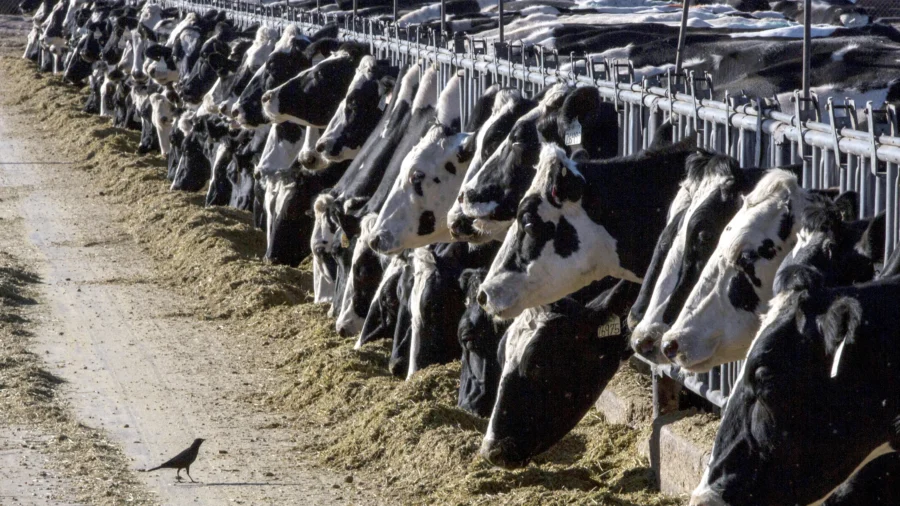The U.S. Food and Drug Administration (FDA) is not sure whether any intact highly pathogenic avian influenza is present in milk sold in grocery stores, an FDA official told a conference on April 25.
“Does any live virus survive the pasteurization process? … This is the key question for us,” Donald Prater, acting director of the FDA’s Center for Food Safety and Applied Nutrition.
FDA officials announced earlier this week that testing on milk from grocery stores tested positive for the avian influenza, commonly known as the bird flu.
The type of testing, polymerase chain reaction (PCR), can detect the intact virus but can also detect residual genetic material from killed pathogens.
“There are not studies directly looking at avian influenza in bovine milk,” Mr. Prater, a doctor of veterinary medicine, said Thursday.
The FDA initially said, after the bird flu crossed into cattle in March, that no commercially available milk would contain the virus because farmers were being directed to divert or destroy milk from sick cows, and because pasteurization would kill any remaining affected milk.
This week, the agency acknowledged uncertainty on the matter. “Based on available information, pasteurization is likely to inactivate the virus,” the agency said in a statement.
Officials pointed to a study that reviewed previous research and found that pasteurization killed some other viruses in milk.
The FDA has refused to say how many samples from grocery stores tested positive and the source or sources of the samples.
Mr. Prater and other officials shed no new light on that front. Mr. Prater merely said that the FDA collected retail samples of “various milk and milk products” and that the U.S. Department of Agriculture tested the samples.
Mr. Prater said the FDA, other government agencies, and outside researchers are engaged in studies to answer a number of critical questions, including whether intact virus survives pasteurization.
“PCR-positive levels aren’t necessarily indicative of live virus so it’s important to understand what we’re seeing in retail milk,” he said.
Some pasteurization experiments involve taking milk samples and applying different time and temperature combinations. One example is looking at whether high-temperature–short-time pasteurization, or 161.6 degrees Fahrenheit heat for 15 seconds, will kill the virus.
The U.S. National Institutes of Health is examining the impact of giving raw milk from sick cattle to rodents, while several other agencies are working on epidemiological investigations into cases of the virus.
Authorities have confirmed cattle-to-cattle transmission of the virus just weeks after the first cases in cattle were confirmed in Texas and Kansas. Experts say that the virus does transmit through milk.
It’s still unclear how long the virus remains viable and the level of virus that makes milk infectious, according to Mr. Prater. He described not knowing as “two really important data gaps that we have.”
Authorities are advising farms with confirmed bird flu infections to discard milk from the animals in some way. They can also feed the milk to other animals but only after heat treatment at levels similar to those used in pasteurization.
Testing so far has confirmed cases of H5N1, a strain of the avian influenza, in 33 cattle herds across eight states. U.S. Centers for Disease Control and Prevention (CDC) officials told the conference Thursday that it and state partners have actively monitored 44 people in contact with sick animals and tested at least 23 people who showed symptoms, but only one human in Texas has tested positive so far.
In another bid to curb the outbreak, U.S. authorities recently ordered farmers to produce negative tests for the bird flu before moving cattle between states. Previously, testing was voluntary and only done on cows displaying symptoms, which include lethargy and discolored milk.
The action will “help us get ahead of this disease and limit its spread,” Agriculture Secretary Tom Vilsack said in a statement.
H5N1 originated in China among birds in the 1990s. The latest strain has been circulating in the United States since 2021. The virus infected numerous flocks of poultry before beginning to infect ruminants earlier this year.
There’s no indication at present of transmission among humans and sequencing from the virus taken from the Texas patient showed no adaptations that would make the virus more transmissible to or among humans, CDC officials said Thursday. Analysis of the testing results suggests antivirals like Tamiflu used against influenza will work in human cases, Vivien Dugan, one of the officials, told the conference.
If more cases among humans appear and vaccines are cleared, then the vaccines would be expected to be at least as good as seasonal influenza shots, Ms. Dugan said. The seasonal shots often provide subpar protection against infection and better shielding against severe disease.
Federal agencies are recommending people take steps such as not consuming raw milk, cheese, or meat from animals with suspected or confirmed H5N1 and avoiding exposure without protection to sick or dead animals or animal feces.
Farmers and farm workers are being advised to carefully handle sick and dead animals. They should wear safety goggles and other equipment to prevent infection, according to the CDC. The agency said doctors should test people who might have H5N1 infections and, if tests return positive, pass on information to laboratories for further analysis.
From The Epoch Times


